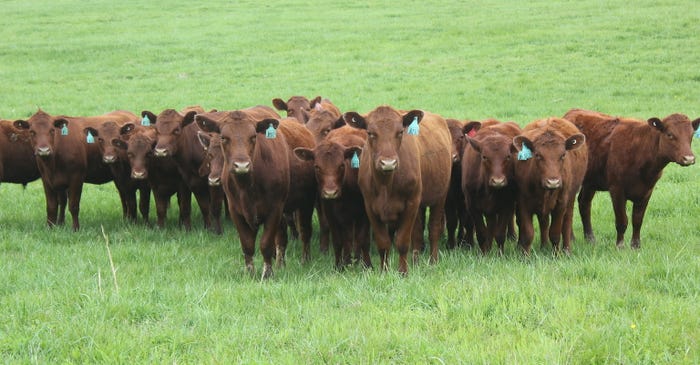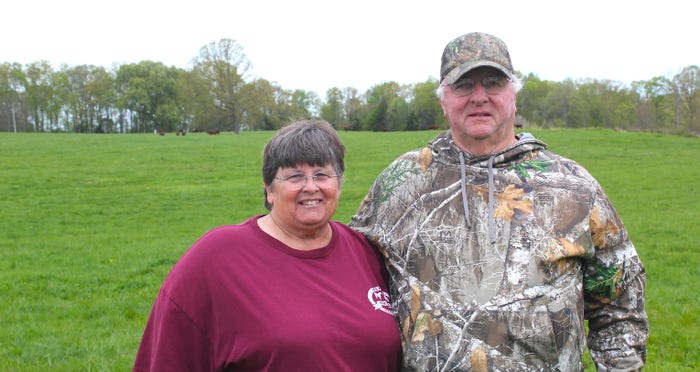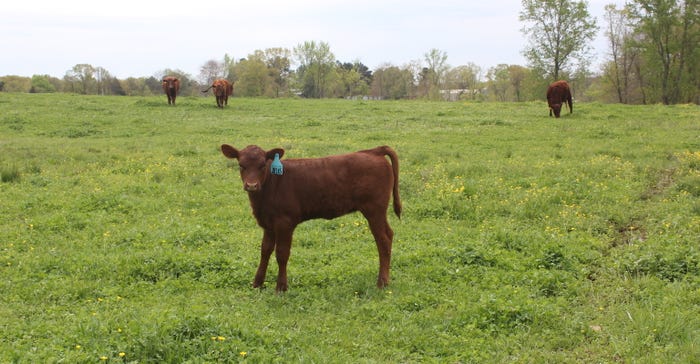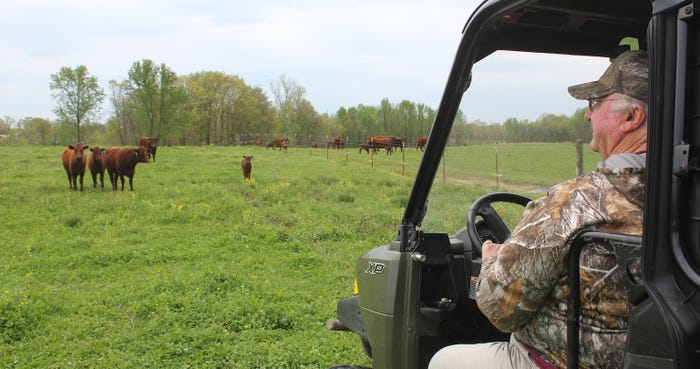
The Red Poll is a heritage breed known for their deep red coloring, docile temperament and excellent mothering abilities. Ginger Rowsey
When Edsel Belyew, of Big Sandy, Tenn., retired in 2011, he planned to spend his golden years hunting and fishing.
His wife, Jan, had other plans.
Jan, who had recently retired herself, wanted to purchase five cows and a bull. Her goal wasn’t necessarily to start a booming cattle operation, but to overcome a fear.
“When I was younger, I was scared to death of cattle,” Jan said.
Even though she is an avid horsewoman who recalls regularly participating in calf pennings in the 1990s, “being on a 1,600-pound horse makes a big difference,” she admits. “I thought if I could raise some cattle up from calves, maybe I wouldn’t be afraid of them.”
Jan researched multiple breeds, trying to find the most docile option for her new venture. She settled on Red Poll, a heritage breed known for their quiet, calm nature, calving ease and excellent mothering abilities. They could also tolerate the heat and humidity of western Tennessee summers. The Red Poll breed seemed like a perfect match.
She just had to convince her husband, Edsel, who initially resisted the idea. Edsel grew up on a beef cattle farm and remembered the hard work. They were supposed to be enjoying a life of leisure, after all. But Jan was persistent.

Flash forward to today and Jan has conquered her fear, walking among her cows as if they were pets. Edsel eventually had enough hunting and fishing, too. Their herd, which started with five cows and a bull 10 years ago, swelled to a peak size of 135 last summer.
In a short time, the couple, along with their children, have built an operation that is widely respected among fellow ranchers. Their rotational grazing strategies earned the Belyews a spot on the International Red Poll Tour in 2017. Edsell is now the vice president of the American Red Poll Association. And in 2020, the Tennessee Cattleman’s Association named him Outstanding Cow/Calf Producer for the state.
“It’s a lot of time and it’s a lot of work, but we love it,” Edsel said.
What was supposed to be a retirement pet project has turned into a second career. While Edsel and Jan are beginning to downsize, reducing their herd to 50 mama cows with three herd bulls, their children, Ryan Belyew and Christy Hodge, are growing their own Red Poll herds.
“It’s been a learning process to get to where we are,” Jan said, “and we’re still trying to be better. Getting into Red Poll cattle was a great decision.”
Red Poll
The Belyews are one of only a handful of Red Poll breeders in Tennessee, a state where Angus cattle dominate. But Edsel and Jan are big advocates for the many positive traits of the Red Poll breed, particularly their docility.
“A lot of times it’s just the two of us working them so calm cattle are a top priority,” Edsel said. “They are extremely docile, but they’re also such a hardy breed.”

The Red Poll was developed in England in the early 1800s. A cross between a Norfolk, a beef breed, and the Suffolk, a polled dairy breed, the Red Poll was used as a dual-purpose breed known for both high quality beef and excellent milk production.
Red Poll cattle were first imported to America in the 1880s. Over the past 50 years, American breeders have emphasized the beef characteristics of the Red Poll. The American Red Poll Association says the breed is renowned for tender, well-marbled beef and high-yielding carcasses. Red Polls are also said to be feed-efficient, with the ability to finish to Choice on grass.
While Red Poll herds are rare in the Midsouth, Edsel says he has seen interest grow, particularly in the last year.
“We’ve really seen demand go up lately,” he said. “People call us from all over the country looking for Red Poll cattle. I think as we’re seeing demand for grass-fed beef grow, farmers are looking to breeds like Red Poll that do well on grass.”
Rotational grazing
The Belyews don’t feed a lot of grain, relying heavily on grass, moving cattle as needed to take advantage of growing forage. One thing that makes the Belyew operation unique is the way they move cattle across their five farms.
Both Edsel and Jan had land come to them from their respective families. At their home in Big Sandy there are around 25 acres of pasture that was part of the farm where Edsel grew up. Forty miles to the south in Holladay, Tenn., Jan had a 150-acre timber farm which also featured about 15 acres of pasture.
As the herd grew, the Belyews knew they needed more pasture, but in their part of the world, land typically goes in small tracts. They leased a 40-acre pasture and bought another 40-acres that overlooks the Tennessee River. Recently they purchased an additional 90-acre farm near their home. As they pieced together the acreage they needed, the Belyews came up with a novel system of managing the five farms that make up the operation.
“I call it the merry-go-round,” Jan laughs.

The Belyews bring cows to calve at the farm near their house where they can be closely monitored. They call it the nursery. When the calves are weaned, the cows go back to one of three farms each with a different herd bull, while the calves are moved to the Lick Creek farm near the Tennessee River, which Edsel says has some of the best pasture. The calves (both heifers and steers) stay at this heifer development center until they are ready to be sold or the females are ready to be bred as replacement heifers on the farm.
“Land is often the biggest obstacle for those who want to get into farming,” Edsel said. “I think we’ve been able to put together what was available and make it work, which is what most people who are just getting into farming will probably have to do.”
The Belyews don’t use a defined calving season, so most of the year there are groups of cattle out with the bulls and rotating through the calving farm. Once cows become pregnant, they can be moved as necessary to manage forage. The system requires impeccable recordkeeping and organization. That’s Jan’s department. She tracks breeding and calving for each cow. She also keeps a daily journal to help her keep track of calving, cattle movements, purchases, sales and vet visits.
“It’s a little crazy constantly moving the cattle, but it works for us,” Jan said. “However, you need calm cattle to make a system like this work. That’s another reason the Red Poll are a good fit.”
Marketing
The Belyews sell mostly open heifers. They don’t want to get into the bull business, because as Jan said, even the gentle bulls “tear everything up.” When they first started it was challenging finding buyers as local farmers weren’t familiar with the breed. Fortunately, social media has allowed them to connect with a wider audience and they now sell heifers to ranchers across the country. They’ve had no trouble finding buyers lately. In fact, they often have to refer potential buyers to other breeders.
“Facebook has been great for us,” Jan said. “We started a Belyew Red Poll Facebook page and began posting photos of our cattle. We don’t post prices, just photos. You wouldn’t believe the number of people who get on Facebook to look for cattle and find us that way.”
The Belyews have not done a lot of direct selling to consumers, although daughter Christy, who has worked as a caterer and has experience in food service plans to begin marketing locally-grown beef. As interest in lean, locally-sourced beef grows, the Belyews see lots of opportunities for the future.
“This has become a family project and we love working together,” Jan said.
About the Author(s)
You May Also Like






